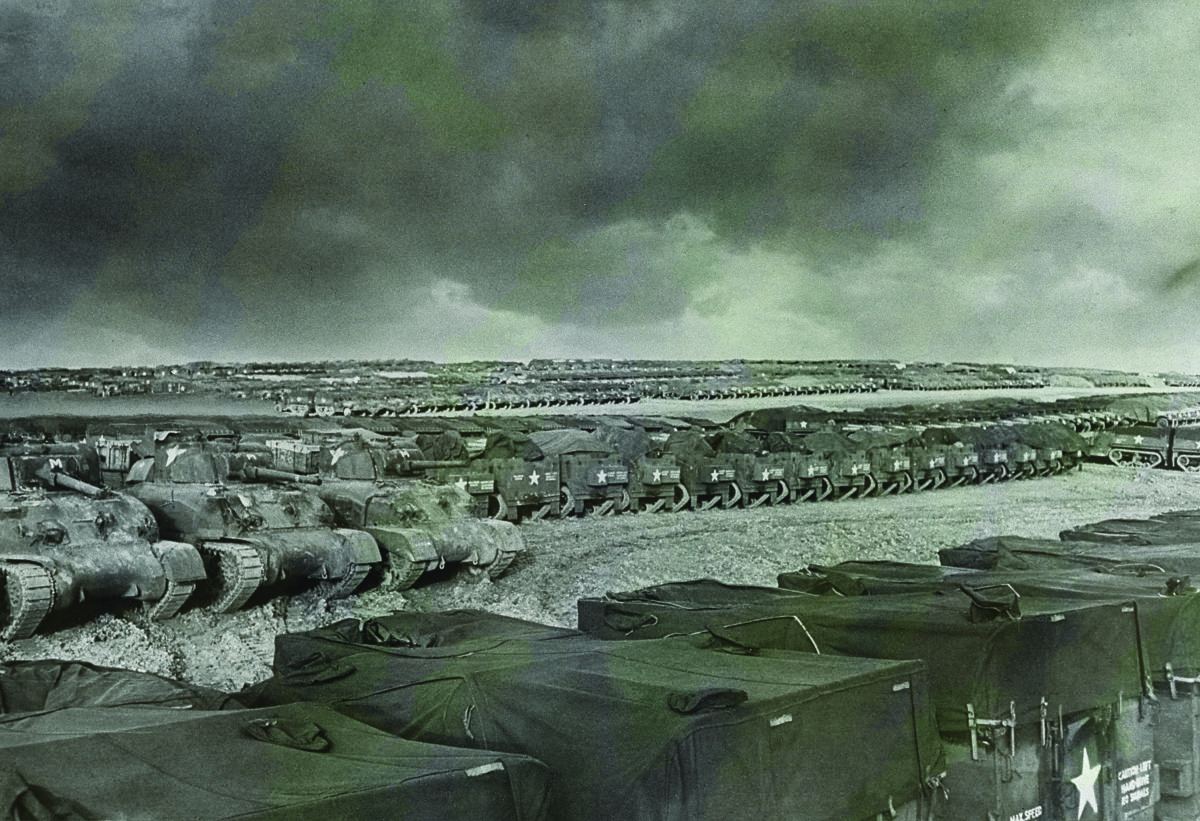We have been paid in francs today, which removes any lingering doubts about our destination,” Lieutenant Jack Swaab, a field gunner with the British 51st (Highland) Infantry Division, jotted in his diary for May 26, 1944. “My own guess is that we shall try and bite off the Cherbourg peninsula.” Swaab was then stationed at a temporary tented site known as an embarkation camp, set up at Leytonstone Park in East London—one of tens of thousands of troops waiting at dozens of such camps in the south of England, near its ports on the English Channel.
Once the final amphibious training exercise had been conducted on May 3, the assault troops and those who would follow them shifted first into assembly areas. There they waterproofed their vehicles, were issued full sets of specialist equipment, and shed any unwanted kit and administrative staff. From those assembly areas, the troops would move to the embarkation camps—also called “sausages” because of their peculiar oval-shaped appearance on military maps—nearer where troops would board their craft. “It was here that many of the troops were to be briefed on their missions,” explained Lieutenant General Omar Bradley, who would command the U.S. First Army for the invasion. “Once briefed, they were to be cut off from the rest of England.”
It was a strange time. All military and civilian mail was impounded beginning on May 27. For security purposes, there was no leave or contact with the outside world. Y-Day—June 1, 1944—by which all troops and materiel for the Normandy Invasion were to be in place, was now only days away.
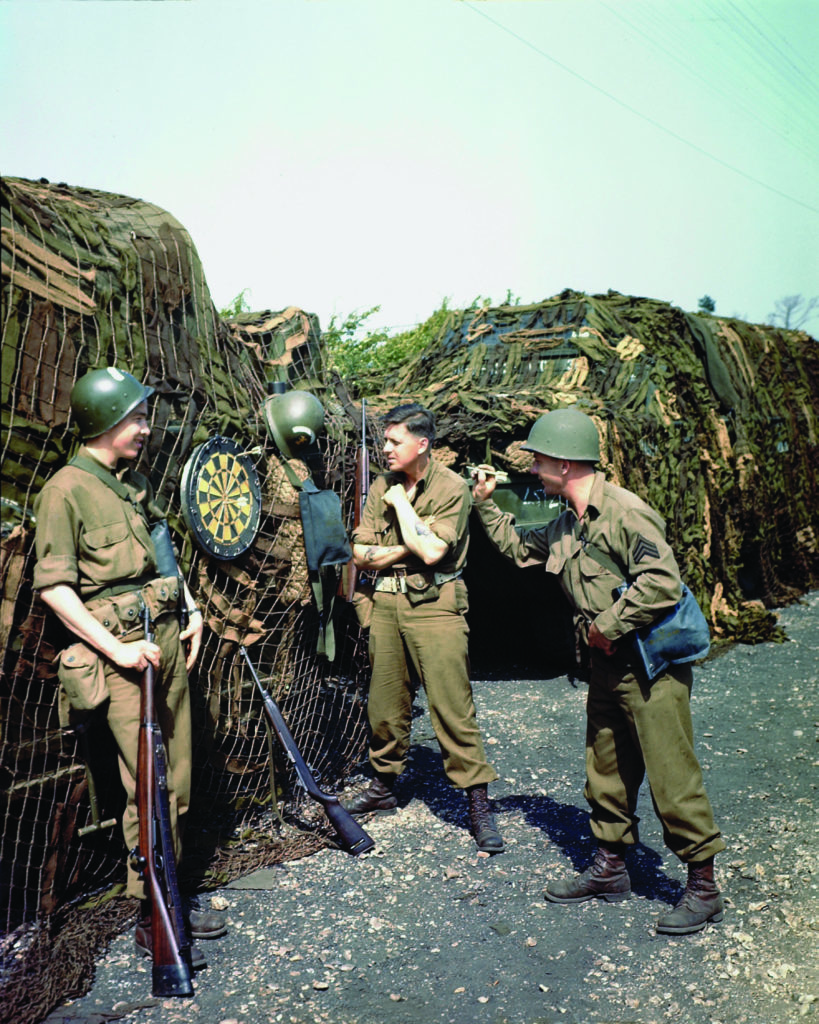
GUNNER ARTHUR BERRY, a signaller with the British 127th Field Regiment, Royal Artillery, was in the same embarkation camp as Lieutenant Swaab. “The atmosphere was unusual, to say the least,” Berry recalled of these final days. “There was almost a bank holiday atmosphere; we watched the latest American films, were fed incredibly well, and given free beer and cigarettes.” Berry and his entire regiment were “surrounded by barbed wire and tents, played endless games in the park of football, cricket, quoits, with boxing, running, and other athletics competitions to kill the time, for we didn’t know how long.”
Added Swaab: “The hot camp—more like a Stalag—daily presents a veritable picture of resigned boredom. The barbed wire is lined with half-naked men commenting vociferously on the passers-by. Girls on bicycles get rousing cheers.”
Captain Douglas Aitken also noticed the girls. The Medical Officer of the 24th Lancers with 8th Armoured Brigade wrote in his diary, “the girls look more attractive when we know we won’t see any for a long time to come. Three attractive ones pass on bicycles on their way to tennis—they look very cool and very English. I occasionally find myself thinking foolish thoughts about not coming back.”
Some camps in the London area were pretty unpleasant. As Royal Engineer Staff Sergeant Ralph Cheshire wrote home: “The place is a derelict area of slums, smashed by bombing. Tents have been placed where there were once houses. Hundreds of troops are here, caged in behind barbed wire; a loudspeaker announces when certain units should be ready to depart. Dust is flying about all over the place: our boots are covered with it two minutes after cleaning; we can taste it in our mouths.”
Charles Hanaway and the 6th Royal Scots Fusiliers may have been at the same camp. From their assembly area, “We drove through the East End of London, where the pavements were thick with people cheering us on,” he recounted. “It was very emotional, but also uplifting to know the people who had suffered so much in those parts were with us in spirit. We finished up in a barbed-wired encampment on Wanstead Flats to stay in tents; civilians…had to walk on the other side of the road, which was more than a little bizarre.”
Australian war correspondent Alan Moorhead echoed this, ruminating, “More and more the feeling grew that one was cut off, that all the normal things would go on, the tramcars and the shops, but they were, for you, of no consequence any longer. In some strange way you had been committed to the landing, to the blank space ahead. But how had it happened, at what point had it been decided that you should be separated from the other people on earth?”
George M. Rosie of the Mortar Platoon, 3rd Battalion, U.S. 506th Parachute Infantry Regiment, traveled by train and truck to the Exeter airfield, where he was sealed in and issued “a ten-cent metal toy cricket for identification purposes: a single squeeze—click, clack—was to be answered by two—click clack, click clack. Ten dollars in French money followed, together with a five-by-three-inch American flag to be sewn on the right sleeve of my jump jacket, ammunition, two hand grenades, and K-rations.” As he enthusiastically set to work on a dinner of steak, green peas, and mashed potatoes, served with white bread and the first ice cream he had tasted since arriving in England, Rosie remarked to a comrade, “They’re fattening us up for the kill.”
Eric Broadhead with the British Durham Light Infantry recalled life in his tented camp about five miles from Southampton: “We discussed our ideas of where [the assault] would be, but the real question was when? Sometimes the question got on our nerves.”
Shortly afterward, his battalion—destined for Gold Beach—was briefed in guarded tramcars on the forthcoming invasion, but much detail was still withheld. Broadhead observed there was “a huge map on an equally huge blackboard. On the map we could see a small strip of coastline; the names of towns and villages were false—New York, Istanbul, etc. So we learned little as to the exact whereabouts of the assault. All we knew was that our objective was to capture the beachhead and press on to high ground and, above all, hold our ground until armored divisions were ashore.”
On departing his assembly area one day, Sergeant Valentine Miele with the U.S. 16th Infantry Regiment recalled thinking he was just “going on another exercise, but instead they drove us to the staging area. Then all of a sudden, we were taken to tents where they had sand tables and maps of the whole beach set out; and postcards, each one with a different picture of our beach; and aerial photos and stuff. After we’d seen those, we were told to stay in the camp: no leaving, no talking to the civilians. There were sentries, armed guards with orders to shoot. All we did there was eat—they fed you 24 hours a day; we ate good.”
One of the very few Australian officers to serve in Normandy, Oxford and Sorbonne-educated Major Henry Baynton Somer “Jo” Gullett had been attached to Australian Headquarters in London when he was seconded to 7th Green Howards of 50th (Northumbrian) Infantry Division a few days before D-Day.
He would be heading for Gold Beach and noted that his briefing “was tremendously thorough. There were maps, sand tables, photographs, and film of the area where we were to land. We went over it day after day until we could picture exactly the country that would lie ahead of us, and what we would have to do when we got there. The only thing we did not know was exactly where we would land,” Gullett remembered.
Sergeant Pat Lindsay, a mortarman with A Company, U.S. 501st Parachute Infantry Regiment, noted that from the sand tables, “each man knew which job he was to do, even down to the direction in which foxholes would be dug.”
“The quality of the models and photographs of our target area was remarkable,” observed British glider pilot Jim Wallwork. “Someone had even made a film of our simulated flight path with which we could practice. The detail was incredible; I remember some wag saying, ‘Someone’s taking an awful lot of trouble over this operation, so we’d better not cock it up or the King will be rather cross!’”
Mary E. Harrison, an artist for the British Women’s Auxiliary Air Force, had trained at art college prior to enlisting. Until 1943, she was at the Royal Air Force base at Watnall, Nottinghamshire, where she made models of targets for Bomber Command. In 1944 she transferred to model-making for the Normandy invasion. “Secrecy was such that for some considerable time we had no idea what these particular models were for,” Harrison recalled, “but on the morning of 6 June 1944, as I sat with several colleagues at breakfast, the announcement was made over our crackly old radio about the invasion. There was complete silence in the mess as we looked at one another in comprehension—so that’s what it’s all been about.”
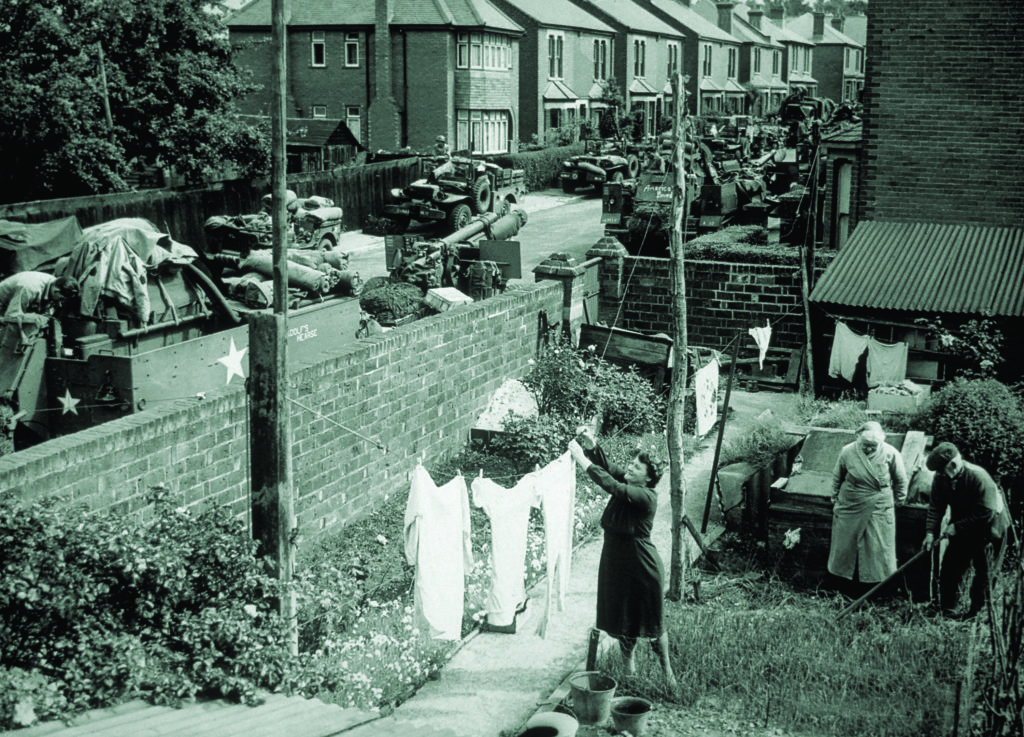
CLUES—BIG ONES—had been all around. Elsie Horton worked at Fort Southwick, the underground complex at Portsmouth, where, as a Wren—part of the Women’s Royal Naval Service—she tracked incoming and outgoing communications signals. “Portsmouth Harbor was a solid mass of ships and landing craft of every description,” she observed of those heady days. “Every little river along the south coast had its share of moored LCTs [Landing Craft, Tank] and LCAs [Landing Craft, Assault],” while the related port town had its share of the servicemen who would be boarding them. “When we were free for an evening, we liked to take a walk, in any direction, and have a chat with these boys, who would often make us a cup of tea.”
Tim Parr, a civilian living in Launceston, Cornwall, noted “in all the lanes at about every 25 yards, the hedges had been cut away and beyond lay endless metal boxes of what I presumed was ammunition, row after row of shells, tins of petrol, wooden crates, all under netting and guarded, of course. Jerry [the Germans] only had to drop one bomb, for the whole of Cornwall was a vast monumental magazine, crawling with left-hand drive vehicles, and these supplies distributed in every field and wood.”
New Yorker columnist Mollie Panter-Downes told her readers, “Living on this little island just now uncomfortably resembles living on the combination of a vast aircraft carrier and a warehouse stacked to the ceiling with materiel labeled ‘Europe.’ It’s not at all difficult for one to imagine that England’s coastline can actually be seen bulging.”
Wren Joan Dale was based ashore managing the paperwork for the 33rd LCG [Landing Craft, Gun] Flotilla, part of Force “G” preparing for Gold Beach. She remembered, “Every day more and more troops, tanks, and guns poured into Southampton. The town was packed; it didn’t seem possible to get any more in, but still they came…. Then suddenly everything disappeared. We woke up and troops, tanks, guns had gone. They were all now crammed into those little ships and nothing of war was visible on the streets anymore.”
The long wait was over.
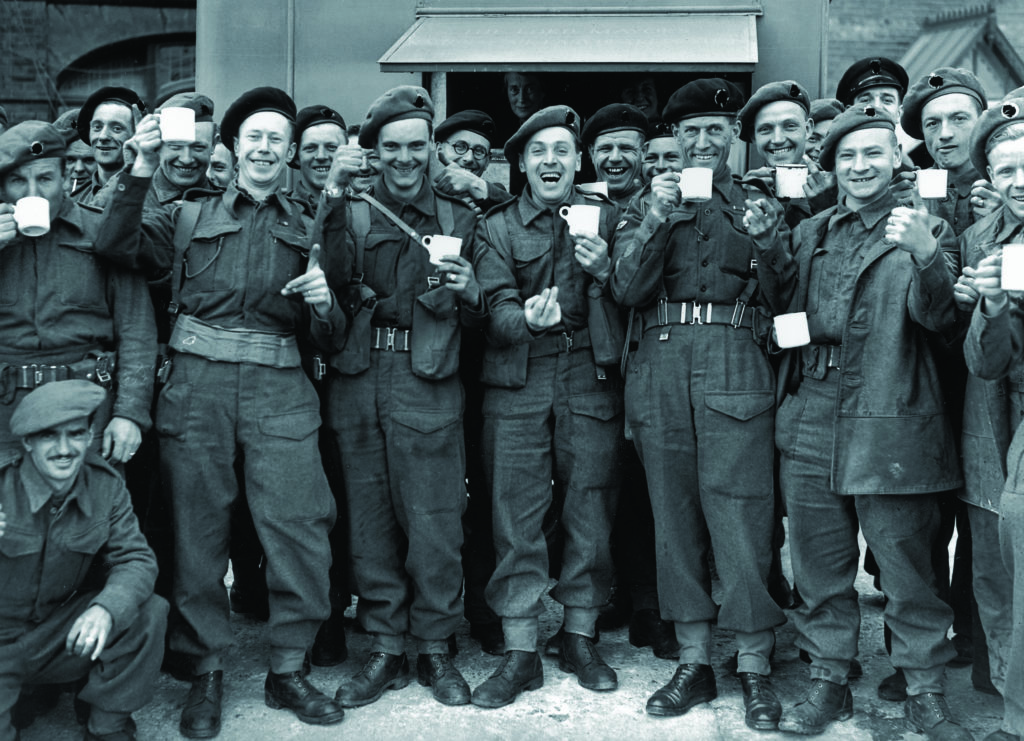
“WE CAME ON PARADE every morning in full battle order, down to the last grenade,” wrote Jo Gullett—the Australian major—“and at least once during the day or night, transport drove up and without warning we piled into it in our fighting order. One afternoon when we had done this, the trucks, instead of going a few hundred yards and unloading us, drove down to Southampton, and we knew it was on.”
Tommy Platt, with the British 1st South Lancashires in 8th Brigade of 3rd Division, recalled leaving camp for the Portsmouth docks and embarkation: “There were security troops—who wore green armbands to distinguish them from assault troops—lining the roads and streets to make sure we couldn’t talk to civilians, but very often trays of beer were brought out from pubs for the convoys, which the security wallahs couldn’t do much about.”
Dorchester resident Gerald Reybold remembered how in his hometown, “every household opposite the tanks made it their business to supply the troops with tea, coffee, and hot water. They gave us candies in return. By night the soldiers huddled around large fires they had lit in the middle of the road and we were serenaded throughout the evening with Jazz, Blues, and old Country and Western songs. In the morning, they were gone.”
In Southampton, the streets “were packed with columns of American and British troops,” recalled resident Brian Selman. “Each night, at 03:00 hours, a column would pull out and drive to the docks for loading. At 04:00 hours, the next unit would arrive for its 23-hour stop. One day, it was heavy artillery; then infantry; the next tanks, vibrating the bomb-damaged houses and bringing down the loose plaster and the odd brick. The petrol bowsers parked nose-to-tail outside our house were the most worrying, even though each house was provided with a couple of large fire extinguishers.”
When it was allowed to cover the great military assembly, Southampton’s Southern Evening Echo reported, “Miles and miles of suburban streets became parking places for the biggest and most fantastic motor show on earth. What made the people of Southampton gasp were the American tank transporters, each as long as a cricket pitch. Their driving cabins were as big as a bungalow, and every vehicle had 18 wheels.” The Echo failed to inform its readers that immediately afterward, Southampton Council’s workmen were quickly on the scene repairing the foot-deep potholes left behind in every road and pavement.
Chuck Hurlbut with the U.S. 299th Engineer Combat Battalion, which was to clear a path through the obstacles the Germans had erected on Omaha and Utah beaches, remembered his drive down to the embarkation port at Weymouth. “In the trees along the roadside was mile after mile after mile of every piece of military equipment you could think of: tanks, guns, jeeps, in their thousands,” Hurlbut recalled. “It was incredible—acres and acres of, well, stuff under netting; and we realized that 98 percent of it was American, had come across the Atlantic. Weymouth was a madhouse. MPs all over the place; you’ve heard of traffic jams, this was the mother of them all. It was total confusion—but organized confusion. The port was full of boats going this way and that; we ended up on an old converted channel steamer, Princess Maude. We laughed and laughed at the name. It was a small boat. By the time we got on it, with all of our gear, there was no place to move.”
Another GI with the 29th Infantry Division remarked what they must all have felt: “Jesus, now we can get started on the road home.”
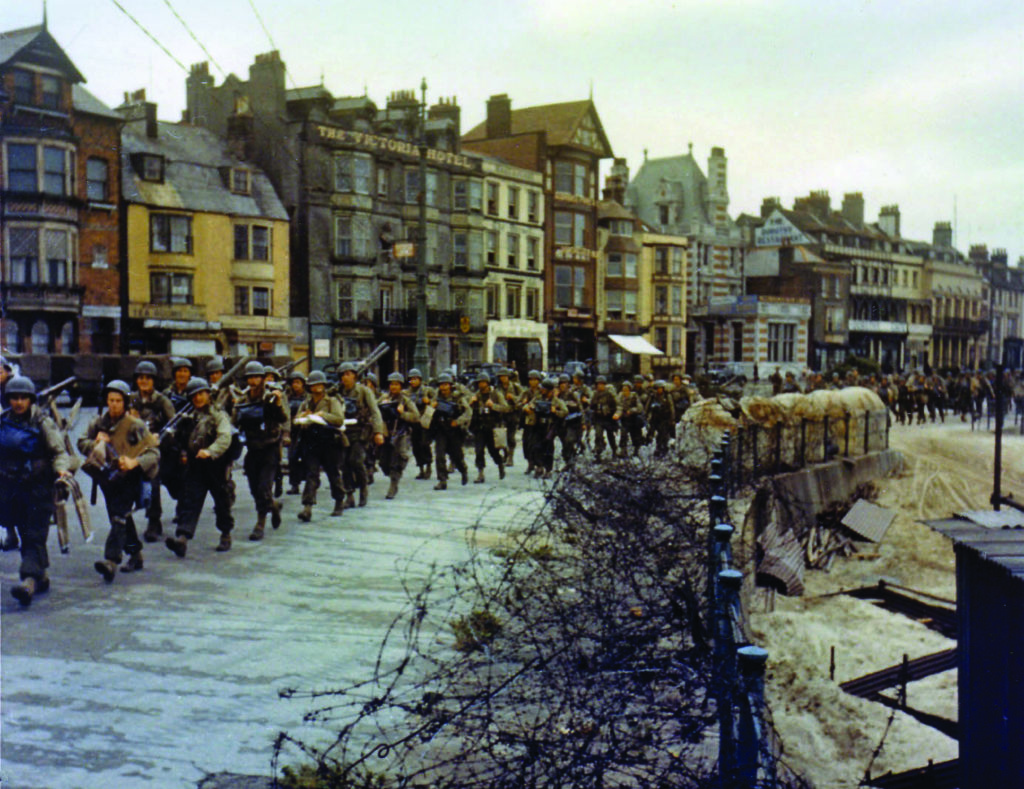
LIONEL THOMAS WAS LABORING on a farm near the port town of Penzance. “One day in May our local bobby [policeman] came round to tell us that all farm activities had to stop,” he recalled. “We discovered why the next day; all the narrow Cornish lanes for miles around were jam-packed with American vehicles—nose to tail—big half-track troop carriers, trucks, jeeps, and motorbikes, with thousands of troops. They were with us for several days, living and sleeping in their vehicles and in our hay-ricks, playing baseball or cards, taking weapons apart and cleaning them, listening to music over their wirelesses,” he remembered. “A few mornings later we came out and everything was completely empty; they’d all crept away in the night and we hadn’t heard a thing.”
On May 23 an American sergeant, heading toward the U.S. 175th Infantry’s marshaling area near Redruth, paused on a hilltop and saw “below us thousands of trucks, jammed with men and equipment, all moving to the south. There were half-concealed air fields, meadows that hid tanks and jeeps, and hedgerows harboring piles of shells. The little towns, still filled with centuries-old quaintness, looked out of place, as troops streamed through in a floodtide towards the sea.”
Nellie Nowlan, then 18, was working for an electronics company that had set up shop in a converted East London Underground tunnel to turn out aircraft components. One day in particular stands out in her memory. She had emerged above ground and was walking toward a busy street to catch the bus. Arriving there she found the street reverberating to the sound of “thousands upon thousands of lorries loaded with soldiers, towed guns, and tanks making their way to [the Royal Arsenal at] Woolwich,” she recalled. The soldiers were laughing and waving at the crowds on the street. “The older people, knowing what was happening, were standing by the kerb with tears in their eyes, saying, ‘Good luck, boys, God bless you,’” she recalled. “When I walked across the road to get my bus they all gave me a wolf-whistle. I smiled and waved my hand, but found I was crying too.” ✯
This story was originally published in the June 2019 issue of World War II magazine. Subscribe here.

